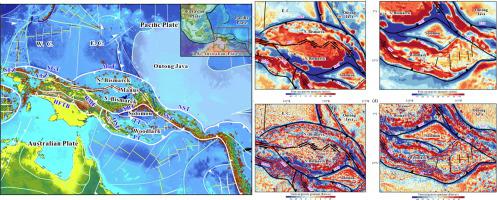Gondwana Research ( IF 7.2 ) Pub Date : 2022-09-10 , DOI: 10.1016/j.gr.2022.09.001 Yinuo Liu , Sanzhong Li , Suhua Jiang , Jie Liu , Yubin Chen , Zhaoxia Jiang , Liangliang Wang , Liming Dai , Junjiang Zhu , Yanhui Suo , M. Santosh , Pengcheng Wang

|
The New Guinea Island is formed under the oblique subduction of the Pacific Plate. The formation and evolution of the microplates around the New Guinea Island are complex and still poorly understood. Here we use the published gravity, magnetic datasets and the CRUST1.0 model, combined with the wavelet multi-scale decomposition and residual crustal gravity anomaly separation, to analyze the crustal structure and boundary characteristics of different microplates. The results show that the gravity and magnetic anomalies have good responses to microplate boundaries, such as deep-seated large-scale faults and subduction zones. Seven microplates (including the Caroline, the North Bismarck, the Manus, the South Bismarck, the Solomon Sea, the Woodlark and the Ontong Java Plateau microplates) have been identified based on their different geophysical properties. Combined with other geological records and plate reconstruction, we analyze the regional tectonic activity, dynamics and microplate evolution in this region. The New Guinea Island was formed and shaped by the oblique subduction of the South Pacific since the Late Cretaceous. Several key events are recorded at 45 Ma, 25 Ma and 5 Ma, which are highly related to the formation of the microplates in the convergent margin. The key events mainly involve the formation and termination of the Melanesian Arc, the collision between the Ontong Java Plateau and the Solomon Islands, and the arc-continent collision at the New Britain Island Arc. These events contributed to a series of island arcs and back-arc basins that further evolved into relatively independent microplates. By analyzing the formation patterns and boundaries of microplates, we classify these microplates into the accretion-derived, collision-derived and back-arc rifting-derived types. The evolution history of each type of microplate is reconstructed in details, which provides additional constraints on the Cenozoic tectonic reconstruction of the Southwest Pacific region.
中文翻译:

新几内亚倾斜俯冲系统微板成因:重磁数据推论
新几内亚岛是在太平洋板块斜向俯冲下形成的。新几内亚岛周围微板块的形成和演化十分复杂,目前仍知之甚少。这里我们利用已发表的重磁数据集和CRUST1.0模型,结合小波多尺度分解和残余地壳重力异常分离,分析不同微板块的地壳结构和边界特征。结果表明,重磁异常对深部大尺度断层、俯冲带等微板块边界有较好的响应。七个微孔板(包括卡罗琳、北俾斯麦、马努斯、南俾斯麦、所罗门海、Woodlark 和 Ontong Java Plateau 微板块)已根据它们不同的地球物理特性进行了识别。结合其他地质记录和板块重建,分析了该地区的区域构造活动、动力学和微板块演化。新几内亚岛是晚白垩世以来南太平洋斜向俯冲形成的。45 Ma、25 Ma和5 Ma记录了几个关键事件,这些事件与会聚边缘微板的形成高度相关。关键事件主要涉及美拉尼西亚弧的形成和终止、翁通爪哇高原与所罗门群岛的碰撞、新不列颠岛弧的弧陆碰撞。这些事件促成了一系列岛弧和弧后盆地,这些盆地进一步演变成相对独立的微板块。通过分析微板块的形成模式和边界,我们将这些微板块分为吸积衍生、碰撞衍生和弧后裂谷衍生类型。对各类微板块的演化历史进行了详细重构,为西南太平洋地区新生代构造重构提供了额外的约束。










































 京公网安备 11010802027423号
京公网安备 11010802027423号